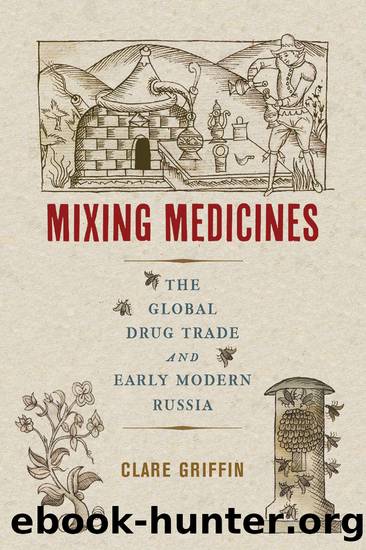Mixing Medicines by Griffin Clare;

Author:Griffin, Clare;
Language: eng
Format: epub
Tags: LCSH: Materia medica—Russia—History, LCSH: Drugs—Russia—History
Publisher: McGill-Queen's University Press
5
The New Textual Authorities
Thus far we have discussed materials like plants, chemicals, and bodies. There is one more vital group of objects for early modern medicine we must address: texts. Texts are, after all, objects. Tara Hamling and Catherine Richardson devoted an entire section of their edited volume on pre-modern material culture, Everyday Objects, to exactly this kind of material.1 There is a whole branch of material culture studies devoted to the materialities of paper, paperwork, archives, manuscripts, scrolls, printed texts, and books of all kinds.2 Paper or vellum is the raw material that is first created, then manipulated into the shape and format required, further changed by being written on by objects such as quills, and finally bound together with glue, thread, wax, and wooden or leather covers. These material processes of texts are culturally dependent: early modern texts were bound together in East Asia in a very different manner than that practised in Western Eurasia.3 Muscovites owned, and made, texts according to their specific requirements. From Apothecary Chancery scrolls to the printed Western European texts in that departmentâs library to hand-written Russian-language medical books, texts were the key materials, and are the only extant objects, of Muscovite medicine.
There were several different kinds of texts used in Muscovite medicine. Central to this study are the scrolls [pl. stolptsy, sing. stolbets], the Muscovite format for official documents, long, coarsely edged narrow strips of paper inscribed in black ink and glued end to end into a ticker-tape bureaucratic record.4 The long strands were fundamental to this kind of textual material culture, as signatures on the back of each join served to verify the chain, and prevent documents being illicitly included or excluded. This practice tied together documents within the department, in Latin and in Russian, and departmental documents with those elsewhere in the bureaucracy, binding the empire together one dab of glue at a time. Alongside those scrolls were bound, Western-European-format manuscript books, beginning with the Slavonic Garden of Health, a format connected to the scrolls by the manner in which the text itself was produced but distinct in the wider format of the sewn-together gatherings of pages, the common use of headings in red, the occasional use of manuscript illustrations, and the hard bindings in wood and leather.5 This form, originally coexisting with the scrolls, began to marginalize that latter information technology at the start of the eighteenth century, as official records were moved into this bound format. As this new kind of bureaucratic manuscript took hold, so did printed Russian-language medical books, produced by a modified version of the Western European movable type press, a technological shift that in turn increasingly marginalized the Slavic manuscript book. Yet manuscript medical books were used and even recopied well into the nineteenth century. Muscovite medical textual objects gradually Westernized in format along with the rest of elite Russian society, but manuscript practices were B movie vampires, endlessly returning from their supposed final resting place.
Considering texts as objects points us toward the processes
Download
This site does not store any files on its server. We only index and link to content provided by other sites. Please contact the content providers to delete copyright contents if any and email us, we'll remove relevant links or contents immediately.
Psychiatry and Racial Liberalism in Harlem, 1936-1968 by Dennis A. Doyle(119)
Doctors of Deception : What They Don't Want You to Know About Shock Treatment by Linda Andre(101)
The Daly Dish Bold Food Made Good by Daly Gina;Daly Karol;(100)
The Stem Cell Hope by Alice Park(91)
The Cure for Women by Lydia Reeder(91)
How Not to Study a Disease by Karl Herrup(89)
Doctoring Freedom by Gretchen Long(89)
Pharmaceutical Medicine and Translational Clinical Research by Vohora Divya;Singh Gursharan; & Gursharan Singh(89)
9781836207139 by Miguel Gonzalez(87)
Tissue Engineering: Principles and Practices by Fisher John P(86)
How We Became Sensorimotor: Movement, Measurement, Sensation by Mark Paterson(83)
Proper People: Early Asylum Life in the Words of Those Who Were There by David Scrimgeour(81)
A Secret Mind by Kaye Kelly(80)
Medical Applications of Beta-Glucan by Gürünlü Betül;(76)
Summary and Analysis of Patient H.M. by Worth Books(72)
Women Doctors in War by Judith Bellafaire; Mercedes Herrera Graf(71)
Mary Putnam Jacobi and the Politics of Medicine in Nineteenth-Century America by Carla Bittel(70)
The Changing Face of Medicine : Women Doctors and the Evolution of Health Care in America by Ann K. Boulis; Jerry A. Jacobs(70)
Mixing Medicines by Griffin Clare;(66)
